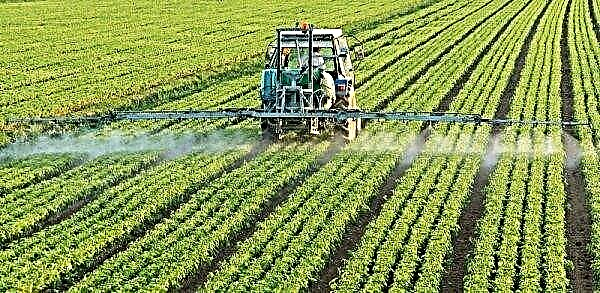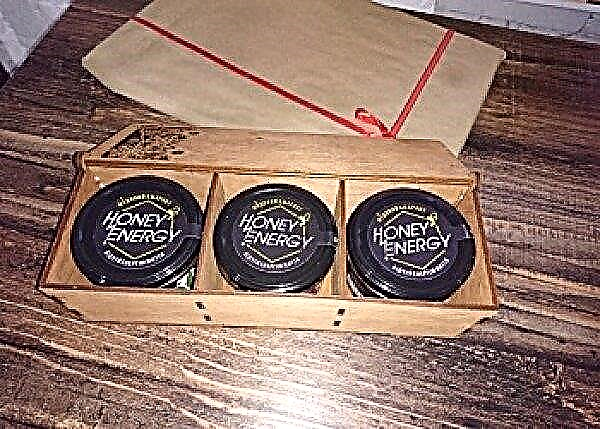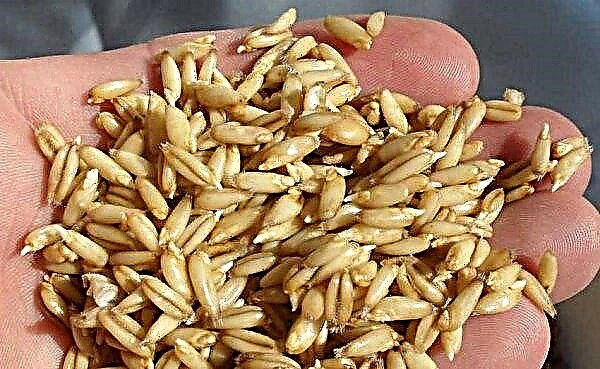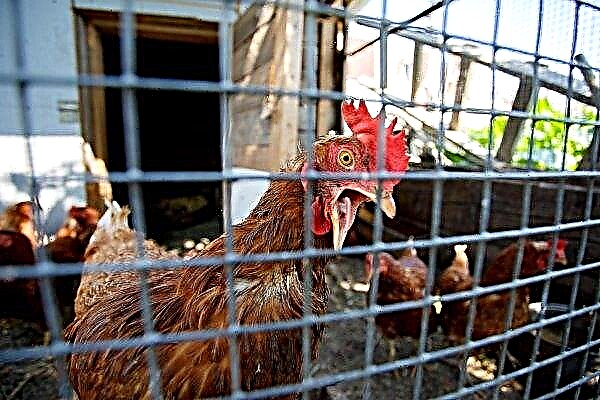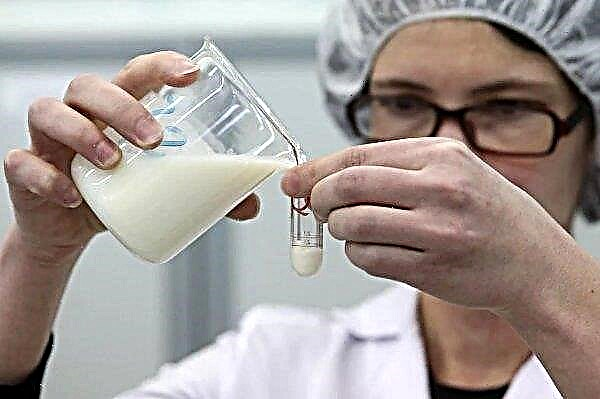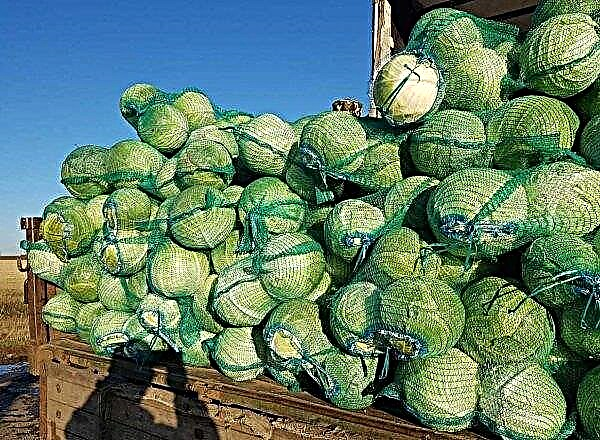The list of exotic plants includes the Compacta dracaena. The commitment of many to the tropical inhabitant is caused by ease of care. Read more about the culture and the features of its cultivation read on.
Description of Dracaena Compact
The popularity of the Dracaena Compacta shrub is evidenced by the fact that it adorns many rooms. This extraordinary plant has migrated to our region from the South African tropics and the Canary Islands. The plant is a family of fragrant dracaena, in which there are from 150 to 400 species.
Did you know? Word «dracaena» quite originally translated from Greek - "female dragon."
The compacta dracaena has dark green (almost black) cone-shaped leaves with a glossy gloss, they are pressed tightly against each other. Forming distinctive layers, the leaves seem to be gathered in a bundle around a thick trunk that looks a bit like a stem. In diameter, the leaf part reaches indicators from 1 to 1.5 m. At home, it can reach 70 cm, rarely blooms. In the natural environment, the growth rate is several times greater (up to 6 m), and small inflorescences of white color cover the culture. It should be noted that dracaena grows very slowly. Lives up to 15 years or more.
At home, it can reach 70 cm, rarely blooms. In the natural environment, the growth rate is several times greater (up to 6 m), and small inflorescences of white color cover the culture. It should be noted that dracaena grows very slowly. Lives up to 15 years or more.
Did you know? According to legend, a warrior who fell in love with the leader’s daughter received a task from his beloved father: to stick a wooden stick in the ground and water it for 5 days. It was said that if after 5 days the stick is covered with green leaves, the warrior will be able to become the girl’s husband. The power of love worked a miracle: during this time, dracaena grew from a stick, which since then began to be considered a symbol of happiness, since it united the lovers' hearts.
Advantages and disadvantages of growing
High viability Compacts and its resistance to the "habitat" make it possible to grow this plant at home.
- There are other advantages:
- does not require special care: the main thing is to choose the right “place of residence”, organize watering and feeding;
- trimming transfers quite easily;
- for the reproduction and transplantation of culture does not require special knowledge and labor.
There are practically no obvious disadvantages of growing. Some gardeners consider slow growth and the ability to succumb to pest attacks as disadvantages. The flower reacts immediately if the owner does not take into account the requirements for lighting, watering, soil.
What you need to do immediately after purchase
Experienced flower growers recommend replanting Compacta immediately after purchase, since the rules of planting a plant are neglected in flower shops. The culture must be placed in a favorable soil, a convenient container and make sure that its root system is in order.
Growing and caring at home
It includes the choice of a favorable place in compliance with all requirements for lighting, temperature, air humidity, the selection of nutrient soil, the organization of irrigation and top-dressing regimes, the observance of pruning rules, crown formation and transplanting of ornamental shrubs. Details for each item.
Microclimate
The compact is quite painfully tolerates bright light, so it is better to define it in a darkened corner, where only scattered light rays will fall on the flower. Preference should be given to the western and eastern corners of the house.
It is categorically contraindicated to place the Compact near the southern windows, as the sun's rays will immediately cause the formation of yellow and brown spots on its leaf plates, which can lead to their death. Such foliage will need to be pruned.
In summer, the plant is advised to relocate to a loggia or balcony, which are protected from drafts and sudden gusts of wind. The culture will report hypothermia with its coagulating leaves.
The tropical origin of dracaena explains its love of heat and high humidity. Optimum temperature conditions for a flower - + 20 ° C - + 25ºС. It should not be allowed to be below + 14ºС, since with such indicators the Compact withers before our eyes.
The air should be humid, within 80-90%, which is extremely difficult to achieve in the winter, when the room is heated by central heating. Dracaena needs moisturizing procedures: she needs to be regularly sprayed with warm water.
Daily spraying is also organized in the hot summer. You need to scrub the leaves from both the upper and lower sides, and also make sure that water does not get into the deciduous funnels, as this can cause the trunk to rot. The plant needs to take a warm shower and to remove dust that has settled on leaf plates. Do not allow the soil to dry out; its moisture must always be maintained. Regarding the soil itself, it is easiest to purchase the right substrate in a specialized store, but you can prepare the necessary mix of soils yourself.
Do not allow the soil to dry out; its moisture must always be maintained. Regarding the soil itself, it is easiest to purchase the right substrate in a specialized store, but you can prepare the necessary mix of soils yourself.
Usually they mix earth, peat and sand in the same proportions, add a little coal, sawdust, which is a preventive measure against root rot. The bottom of the tank must be well drained to prevent stagnation of water. 2-3 times a month, engage in loosening the soil. Such procedures increase the permeability of the soil.
Important! Experienced gardeners, in addition to spraying, recommend wiping exotic leaves from time to time. «inmate» at home. Performing such a procedure, you can notice pests that attack the plant in time.
Watering and feeding
Dracaena Compacta needs regular and plentiful watering. In summer, it is watered every day. In winter, the number of irrigations is reduced to 3 times a week. You can find out if a plant needs watering by probing the soil.
If the top layer is 2-3 cm dry, then you need to water the plant immediately. Half an hour after watering, the water that has accumulated in the pan must be drained.
Excessive watering can also harm the crop, so make sure that the soil under this representative of the tropics is always moist (but not swampy). Mold must not be allowed: this can adversely affect the culture and create favorable conditions for pests.
It is recommended to take filtered water for irrigation. Temperature - room.
Top dressing should be applied every two weeks from spring to autumn. In winter, a dormant period begins, so the plant does not need fertilizers. You can resort to using complex fertilizers for dracaena, palm trees (for example, "Ideal", "Rainbow"). You can use liquid top dressing with a high content of phosphorus, potassium, nitrogen. These components should be added to water for irrigation.
You can use liquid top dressing with a high content of phosphorus, potassium, nitrogen. These components should be added to water for irrigation.
Trimming and shaping the trunk
For dracaena to grow lush and slender, timely trimming and trunk formation are necessary. The most favorable time for the procedure is May-June. It is during this period that the maximum activation of growth and the formation of new buds in the plant are traced.
The rudiments of shoots perform regenerative functions: they secrete hormones that heal the section as quickly as possible and take part in the formation of a new magnificent crown. As a rule, the top is cut off. You can choose the cutting height at your own discretion (depending on how effectively the plant fits into the interior).
Important! You can trim only those plants whose growth has reached 30 cm (referring to the distance from the soil to the place of formation of the upper leaves).
The cut off top should not be thrown away: with proper care, it can take root. Get another plant. Use a sharp knife to trim. Try not to squeeze plant tissue.
Sometimes there are emergency situations, as a result of which pruning is necessary unscheduled (for example, if the culture is broken). They are cut according to the same principle, and the place of cut is treated with a mixture of garden varnish or paraffin (this measure is also recommended for planned pruning).
This will protect the flower from drying out and evaporation of moisture. In the place of the cut, the rudiments of new leaves or shoots are formed.
Dates and technology of transplantation
Every 2 years an adult Compacta (from 5 years old) needs a transplant, which is desirable to organize in the spring, after awakening the culture from the so-called winter hibernation. Young plants are transplanted annually.
With each transplant, you need to choose a container whose diameter is 3-4 cm wider than the previous one. Pots made of natural materials (clay, for example), providing a good air exchange are welcome. When transplanting, follow the above tips for selecting soil.
Important! Before transplanting, it is recommended to pour over a clay pot with boiling water and leave it in the water for a short time. This helps open the pores of the pottery.
Landing technology is as follows:
- drain the soil using perlite or coarse sand (2-3 cm);
- a substrate is poured onto drainage materials;
- Dracaena is placed in the center of the slide from the substrate, and, accordingly, the pot. The root system of the plant before that already needs to be cleaned of the earth in which it grew before, and also carefully inspect it for pests and damage;
- carefully spread the roots and fill them with soil, a little tamping;
- water the plant and transfer to a corner favorable to it.
It happens that the plant fades after transplantation. This is due to the so-called stress (the flower survived something similar to a small operation).
Breeding methods
There are 3 main methods of reproduction: apical cuttings, cut off by stem fragments and seeds.
Important! The trunk of the cut top must be cleaned of leaves.
It is most optimal and simple to resort to reproduction by apical cuttings. The trimmed top is placed in water, which is recommended to "fertilize" with a few drops of the drug called "Heteroauxin". When the roots appear, the process is transplanted into the ground and taken care of, observing all the above rules.
The essence of reproduction by dividing the stem is to divide the trunk into equal cubes with a length of about 7 cm each. The cut points are treated with “Kornevin” or poured with warm paraffin. Such cuttings are immediately placed in a peat-sand substrate.
It is advisable to create a small greenhouse above the container with cuttings using a film. The tank itself is transferred to a warm room (+ 25ºС) with high humidity. The appearance of the first leaves makes it clear that it is time to transplant the plant into a separate pot.
The advantage of this method of propagation is that containers with cuttings are very easy to transport.
The most troublesome and difficult method of reproduction is seed. Seeds are usually purchased in specialized stores. Immediately before planting, they are soaked in a Zircon solution, which helps to increase seed germination, stimulate the growth of a future plant and increase its immunity.
Did you know? Some species of dracaena the juice red (“dragon's blood”), which in ancient times was actively used in medicine, as well as to give bright color to wine and tea products. Today it is added to varnishes for working with metal.
The temperature of the stimulating solution should be + 30ºС. Seeds are sown in a substrate for palm trees, watered and covered with a film, transferred to a warm room. After 1-2 months, the seeds will germinate. With the advent of sprouts, the film is removed. Seedlings must be provided with regular watering, fertilizers; they are dived to a permanent place only after they grow (about 6 cm).
Seedlings must be provided with regular watering, fertilizers; they are dived to a permanent place only after they grow (about 6 cm).
Features of the flowering period
Not all owners of the Compact know about the features of its flowering. It blooms once every 7-10 years. Representatives of the genus of fragrant dracaena, unlike their "relatives", emit a pleasant aroma. Their flowers are collected in loose inflorescences, panicles of white color with pink stains.
After flowering, only one seed grain is formed. The fruit is orange in color, similar to a berry.
Diseases, pests and methods of dealing with them
Often the appearance of the plant worsens, which can be caused by the development of diseases and the appearance of pests.
You can easily find out what exactly prevents the dracaena from actively developing by studying the symptoms:
- Withering and drying of leaves indicates a lack of moisture in the soil and the environment. Similar symptoms develop and as a result when using cold water for irrigation.
- If foliage formed colorless spots, this indicates that the plant received a burn: came under direct sunlight. The appearance of brown spots can be triggered by insufficient watering. Similar symptoms appear as a result of the location of the flower in a draft.
- Blackened Leaf Edges they signal that the plant suffers from excessive dryness of the air, yellowing indicates a lack of fertilizer.
- About hypothermia the culture reports twisting the leaves.
- Withering and depression culture signals the decay of the roots.
- Dracaena can hit phytosporosis, which is accompanied by the formation on the leaves of light brown spots surrounded by a dark border, or phylostictosis - the appearance of brown spots with yellow edges and dark dots. In both cases, treatment with fungicides is needed - Phytosporin, Fundazol.
- If dracaena started dropping leavesIt’s worth a thorough inspection. Such a phenomenon is a sign that the flower succumbed to the attacks of pests: thrips, spider mites, scale insects. To get rid of them, washing the culture with soapy water and then treating it with an insecticide (for example, Fitoverm) will help.
 As you can see, despite its tropical origin, the compacta dracaena coexists well in a home environment far beyond the tropics.
As you can see, despite its tropical origin, the compacta dracaena coexists well in a home environment far beyond the tropics.Important! Do not sound the alarm in case of yellowing and falling of the lower leaves of the plant: this is a natural process.
Moreover, it becomes a “highlight” of the interior, introducing notes of exoticism and elegance.

